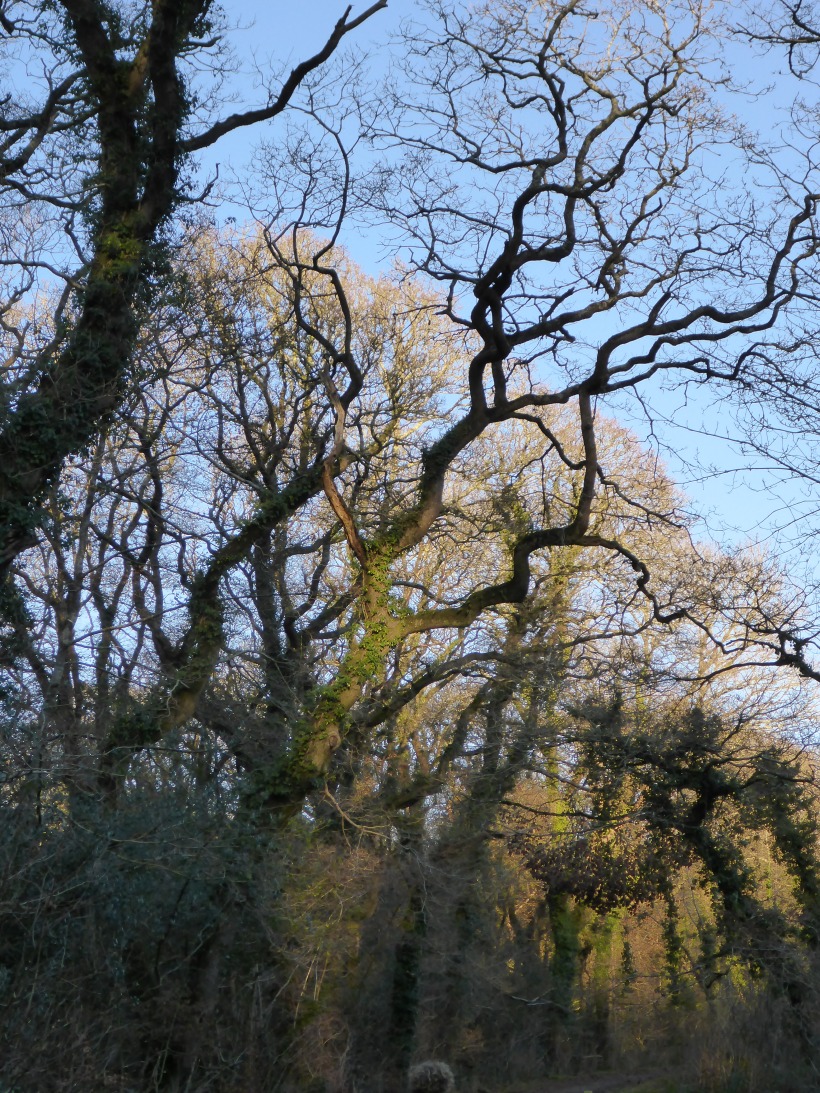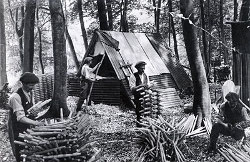
“There is nothing more beautiful than a tree”
I stood at the edge of my wood today ankle deep in the ruts left by heavy machinery looking at shattered limbs, torn and exposed roots and whole trees rent apart. Vast piles of broken boughs and branches around the boundary and 30 feet into the ancient oak, holly and hazel wood.
I call it “my wood” though I do not own it . It is “my wood” because I have taken its cool fragrant air into my lungs of a summer’s evening. It’s mine because I have lain under its spreading canopy in a full gale, listening to the rush and sighs of the wind through the boughs and watched the grace of them dance. It’s mine because my children played here and because I did too. It’s mine because it’s in my heart like love or hope.
Why has the farmer done this? The assault is beyond understanding, Without care, without craft, without skill or thought. “ It was encroaching on the fencing” I hear him saying in justification. “it needed clearing back”. He cleared it back OK, with shocking industrial scale violence and huge machinery.
Just another farmer tidying up his field boundary. they are supposed to be the “stewards of the countryside” yet All around I see the constant erosion of beauty. And I see nature gently and persistently trying to restore itself.
Self formed of sunlight. A tree is a great fountain of earth energy made solid in time. Forked-lightning branching up from the earth, branches and twigs crackling up into the sky. Not a momentary burst but one that lasts hundreds of years or more. It’s just a matter of attention span.
In a tree’s shape can be seen the form of airways of the lung, the networks of nerves and blood vessels, the fluid branching of riverine estuaries and ocean currents; a shape evolved for exchange, for collection and distribution. Collecting sunlight and carbon dioxide, distributing oxygen, water vapour. Deep in the wood, that energy rushes in a great torrent up the trunk roiling and rippling in the confluences of boughs, eddying around branches in spirals and vortices, pulsing up capillaries to twig and leaf.
Beneath the spreading canopy, leaf litter teams with insect life and keeps moisture in the thin but rich fungus-laden soil holding up to ten times more water than bare ground; a great sponge, a purifying biofilter.
Below, deep among the filigree roots, a wider communication is happening . Networks of symbiotic mycorrhizal filaments are plugged into the matrix of the “woodwide fungal web” where microbe assisted gas and chemical exchanges are happening. Water and dissolved minerals are drawn up, ebb and flow, made sweet by spring’s promise; the sap throbs with lunar and seasonal pulse up into the canopy where every leaf and pore transpires in moisture laden breath; emitting turpines and other subtle volatiles to create and seed clouds, bringing rain to feed the cycle of nutrient dissolution and absorption.
A woodland is a super-organism tying the earth and sky together. It supports a great community of co dependant life, each individual relying on the greater whole to provide a home or food, each with an interdependence and communication. Lichens, mosses, creepers, fungi, ferns, birds, bats, bees, insects, mammals, microbes, viruses and humans. All enabled.
And when, in time, a tree dies or is felled by fungus or storm or broken by megafauna its great store of energy is given slowly back to the soil; food and habitation for myriad other beings. Plants and creatures of the earth and of the air linked together, a symbiosis vastly greater than the sum of its many parts; a great bioaccumulator of fertility and a dynamic store of diversity.
If the Stone Age overlapped the Bronze Age, and the Bronze the Iron, the Wood Age came first and we have left it only in my lifetime. From the cradles that rocked us and the houses we lived in, the temples and cathedrals we worshipped in, the carts and carriages that carried us to the ships that we explored and traded in. The shafts of spears and limbs of bows, the charcoal to make gunpowder for conquest. The casks that held wine or oil, the paper and books that held our stories. The tree gave us the framework of existence. Even cars, planes and TV sets were framed in wood.
For long before we came along with our axes and fire to clear the forests and grow field crops and graze the beasts we had domesticated, the elephants came and went among the great wild wood, grazing, trampling, breaking branches and munching the tender leaves.
The trees evolved, responding to the damage by becoming immortal, so now when broken or cut instead of dying they grow even more vigorously and send out fresh new shoots and branches. We learned too, finding that when a young tree is cut down in winter the next spring many more shoots will grow back straighter and stronger than before which could be harvested when of a useful size. Each stem will, if left to grow, becoming a new trunk, a new tree, with the same roots. This process of cut and regrowth can be repeated again and again ad infinitum with no loss of vigour. Roots integrated into the life-force of the earth power the tree to grow and regrow. And each time the tree is cut the canopy is opened up and light floods the woodland floor. And from the seedbank held in the thin woodland soil plants burst out of dormancy to grow and fill the gap..
Coppicing is a very ancient practice and relies upon an active, ongoing participation between people and the woods. A dynamic relationship where the need matches the return. Whether it be forage for animal feed, or fire wood ,or whithies for baskets, or hurdles, or wattle for house walls, or poles for tool handles, or bean or hop poles, fence posts or vine trellis, fish traps or barrel hoops, walking sticks for wounded soldiers or legs for chairs; it provides material that is strong, flexible and easy to work. And it can be perpetually replaced. reinforcing an an ecosystem with vigour and diversity.
Almost 4000 years ago a track was built across the soft ,marshy ground of the Somerset levels. Made of alder and oak with panels of woven coppiced hazel panels, it remains one of the oldest examples of working wood. In the river valleys of South West England, for a thousand years the oak woodlands were cut on rotation giving bark for the leather tanning process, firewood for the hearth and charcoal for the forge. In the Weald area of Kent and Sussex the Romans mined and smelted iron continuously for more than 200 years using charcoal made from coppice. Almost two thousand years later it remains one of the most wooded parts of the country, perhaps those woods have the selfsame roots as when they were first coppiced.
But now the woods which once rang to the sound of the woodsman’s axe and people plying their crafts are quiet but for birdsong and the roar of the nearby motorway.
Working with coppiced wood cut straight from a living tree is a very different craft to what is normally thought of as woodwork. The joiner or cabinet maker generally work dried, seasoned wood and traditionally the carpenter built houses of timber usually cut from felled mature trees. Fresh “green “ coppiced wood still has a very high moisture content and is therefore softer more flexible and “cleaves” [splits] easily and controllably. It can be bent and woven into a wide range of products, its lightness, flexibility and strength made it ideal for fish traps, baskets and sheep hurdles. Thatched roofs were “stapled” in place with “broches” of hazel. Barrels and casks were held together with hoops of split chestnut. It was fashioned into clogs and trugs and “turned” into components for chairs (the famous Windsor chair “bodged” in the beech woods around High Wycombe)

The tools needed for working fresh green wood were basic The axe and billhook. The saw, the froe, the knife. mallet and chisel, brace and bit. The drawknife and shave horse; crude tools that belie their simplicity. The craftsmen and women who worked the woods often also made it their home and workplace. No need for a workshop under the spreading greenwood tree. If you can knock up a seasonal shelter thatched with bracken, why transport heavy wood to the village when it can be roughed out and dried where felled? Only the components carried to the workshop for finishing, leaving the sawdust and shavings to gently decompose into the woodland soil, enriching it for the next cycle of growth. A truly “green” craft – making useful products that, at the end of their use, return to nature’s cycle.
Now though, we live in the Plastic Age where the artefacts of the Age of Wood have lost their relevance. But now a new realization may finally be dawning. That trees, woodland and the rich biodiversity they hold have a value beyond utility. Also a realization that acknowledges that nature has limits, is fragile and is in deep trouble. That the very survival of life depends on a new way of living and engaging with our environment.
The way we are living is making us sick of heart; workplace stress, inactivity, lack of access to nature, isolation. But the woods can heal us, bring peace, perspective, time and space to reflect. No more can we allow woods to be destroyed in a blind search for profit or tidiness. It is time to look back and relearn how to live within the means of our land, to remember our childhood wonder, to learn humility and respect for the quiet powerful wisdom of nature, to recognize our place within her family and to accept responsibility for our actions. It is time to realise that a healthy environment is our birthright not a by product or luxury and it is time to claim it back.
As individual humans it appears we have little power to personally alter the course of the destructive culture around us. But being an agent of change can start with the most simple, yet profound physical act. Planting a tree is not a metaphor, it is an action. In that moment one becomes a real participant in the process of healing the damage. Not just a passive, hand wringing observer or well meaning but unwitting collaborator, but a true activist of positive change. It is time to take back our true birthright, to participate as enablers in the diverse, abundant glory of the forest and become agents of Nature.
Plant a forest of hope.
the big idea.
To assist the restoration of the land by healthy and positive participation with nature I have initiated the Tree by Tree Project.
Tree by Tree Event
To launch this project we will be having a fund raising event. We will planting the first plot this year. it is a two acre field at Crowborough Farm at Georgeham in North Devon. We will be planting 1600 mixed native hardwood trees on the 8th and 9th of April. On the Saturday night we will be having a ticketed party with live music, food and drink, fun and frolics. the aim is to try and raise enough money to buy or secure the next plot and put it to woodland for perpetuity. This could be anywhere in the SW region wherever we can secure the Land
come and plant trees, party and help us get the next plot to grow…
A forest of Hope.
.
.